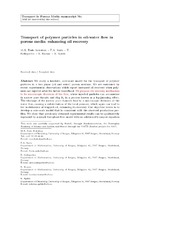Transport of polymer particles in oil–water flow in porous media: Enhancing oil recovery
Peer reviewed, Journal article
Accepted version
Permanent lenke
https://hdl.handle.net/1956/21872Utgivelsesdato
2019Metadata
Vis full innførselSamlinger
- Department of Chemistry [449]
Originalversjon
https://doi.org/10.1007/s11242-018-1175-2Sammendrag
We study a heuristic, core-scale model for the transport of polymer particles in a two-phase (oil and water) porous medium. We are motivated by recent experimental observations which report increased oil recovery when polymers are injected after the initial waterflood. We propose the recovery mechanism to be microscopic diversion of the flow, where injected particles can accumulate in narrow pore throats and clog it, in a process known as a log-jamming effect. The blockage of the narrow pore channels leads to a microscopic diversion of the water flow, causing a redistribution of the local pressure, which again can lead to the mobilization of trapped oil, enhancing its recovery. Our objective herein is to develop a core-scale model that is consistent with the observed production profiles. We show that previously obtained experimental results can be qualitatively explained by a simple two-phase flow model with an additional transport equation for the polymer particles. A key aspect of the formulation is that the microscopic heterogeneity of the rock and a dynamic altering of the permeability must be taken into account in the rate equations.
